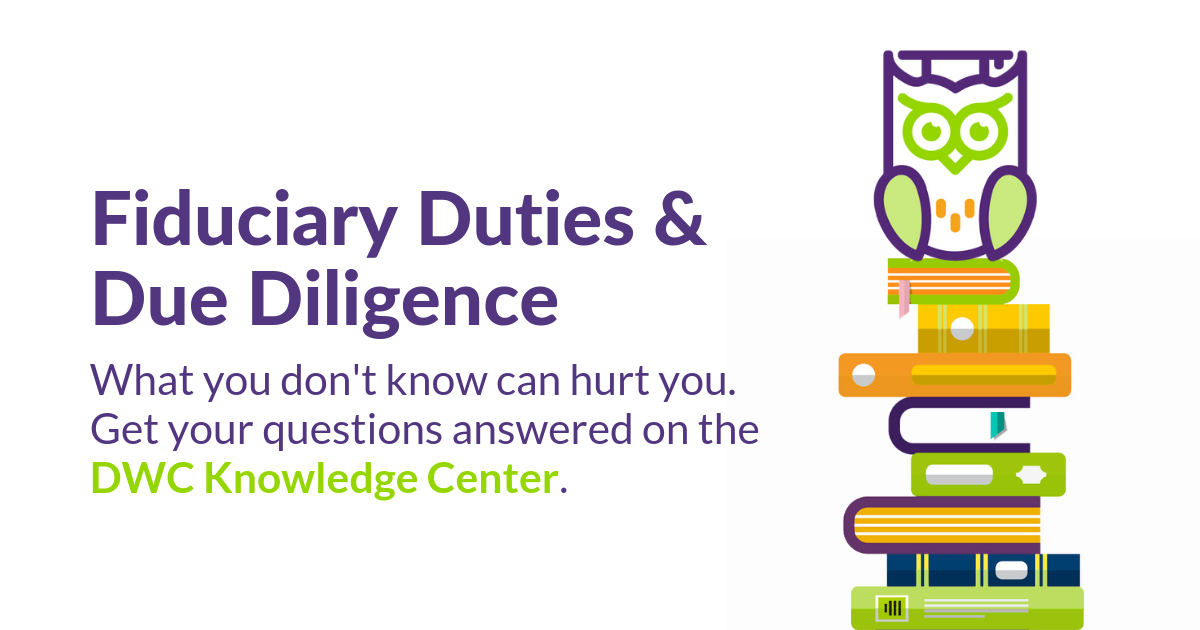Timeless Tips for Selecting Plan Service Providers

Our industry has experienced a lot of change in the last 30 years — from service models to systems to sales pitches.
Back in the late 1980s, delivering hard copy participant statements 120-180 days following the end of the year was the gold standard. In fact, in the days before mutual funds, delivery of participant statements in any shorter timeframe was considered remarkable. As the trend shifted to quarterly reporting, some providers emphasized the ‘cool factor’ of their participant statements; others, the ability to customize reporting at the plan sponsor level; still others emphasized lower costs and stuck with a ‘just the basic facts’ model.
At DWC, we find the “art of the defined contribution sale” to be an interesting case study. In the 1980s, service contracts were far shorter and the key provider contact was typically from the investment department of a large, national financial institution or insurance company. Today, a vast majority of plans of all sizes work with an investment professional and any plan sponsor representative responsible for selecting or recommending new providers is most likely contacted well over 50 times a year (or more depending on the effectiveness of the SPAM filter).
Here are a few of our favorites from the walk down sales memory lane.
Search Consultants
These consultants offered to help plan sponsors wade through the process of vetting and selecting service providers. Some recused themselves from the list of candidates, instead including only those providers with a proven track record of success. Others would throw their hats (or those of an affiliated company) in the ring and stacked the deck with other “finalists” that were obviously not a good fit in order to ensure a desired outcome.
Both types had a favorite tool of the trade — the Request for Proposal or RFP — which was 500 pages (slight exaggeration) of Q&A drudgery for the candidates who wished to be considered. Some of the RFP “classics” included the now infamous Y2K preparedness questions, inquiries into the number of clients lost in the last 3 years (no, the real number, not just the ones lost to acquisitions), and the all-encompassing “please describe your systems” (for the tech-savvy in the group).
Advisor vs. Broker
Simply put, the investment advisor charges a fee for service and a broker is paid a commission. Typically, both are paid from plan assets, either as a direct charge (in the case of an advisor) or via fees built into the underlying investment option (in the case of a broker). Brokers could claim they didn’t “charge extra” beyond the fund expenses, but the advisor could highlight the ability to provide unconflicted advice.
DIY Websites
These sites tried to be a one-stop-shop by collecting RFP-type responses for many providers who subscribed to the service so that sponsors could do their research and make their choices all in one place. Unlike travel sites, however, these sites didn’t provide discounts, so once the research was done, sponsors, like travelers, were free to go directly to the providers to negotiate the best deal.
And how about some of those sales pitches that have been around forever?
And how about some of those sales pitches that have been around forever?
"The entire process is seamless."
With thousands of pages of fine print governing this business, there are bound to be occasional bumps in the road, no matter how seamless anyone tries to make it.
"We are proactive."
We have yet to find a service provider that says they are not proactive, but we’ve seen many who don’t follow through on it.
"Our services are free! You don't have to pay a penny."
Really? Who works for free? The plan sponsor might not be writing a check, but there is a cost. And, since the business owners usually have the largest plan accounts, they are paying a larger dollar amount of the total fee; they just don’t see it.
With fee disclosure, wasn’t benchmarking supposed to be easier? We don’t know what is shorter, the Healthcare bill or the service provider fee disclosure documents.
As the 401(k) plan evolved, so did the reasons for changing service providers. We’ve gone from annual valuation to daily valuation; from single fund platforms to open architecture recordkeepers; from hard copy deferral and investment elections to self-serve websites and live participant call centers. And don’t forget revenue sharing, another tool often used to sell that “free” 401(k) plan.
Getting to the point of the article, if you or your client is looking to hire a new service provider, the secret to successfully selection boils down to a few key characteristics. Whether it is an investment advisor, recordkeeper, TPA/consultants, attorney, accountant, etc., if the provider possesses these traits, chances are good they are an organization with whom you want to work.
Ethics
This may be the most important factor to consider. Why? Because an ethical service provider understands the necessity of the other factors in this list if s/he is going to be in business. So, what do we mean by ethics? We think of it as doing the right thing even when there is a slim chance of getting caught. Consider a couple of common examples:
Magic Amendment
Unlike disappearing ink, the magic amendment has ink that magically appears in the form of a signature when an auditor asks about a missing document. Keep in mind that retirement plans afford substantial tax benefits to those who play by the rules, including maintaining timely executed documents and amendments. Backdating an amendment essentially amounts to tax fraud. Yep, the same thing the Feds used to finally bring down Al Capone (the fraud part, not backdating his 401(k) plan). It might sound like a reasonable solution to a short-term problem, but the long-term ramifications can be quite ugly. An ethical service provider looks long-term and advises clients to take advantage of the IRS voluntary correction program rather than trying to be the next David Copperfield. After all, a provider’s magic tricks frequently result in the plan sponsor’s liability.
Missing Loan Payment
Sometimes a participant misses a payment on his/her plan loan. If not discovered and corrected on a timely basis (usually four to six months), the outstanding balance is taxed as a distribution. Sure, a provider might suggest quietly fixing it after the fact and not reporting it, because no one will ever be the wiser. But again, that short term thinking puts both the plan and the participant at risk. Is it really prudent for a sponsor to jeopardize the entire plan by hiding one participant’s tax liability? Ultimately, the plan sponsor must make the decision, but an ethical provider will explain the options — pay the tax, use the IRS voluntary correction program, etc. — and discuss the pros and cons of each rather than giving an easy answer with potentially harmful long-term results.
Another reason to work with ethical providers is that they will take responsibility for their mistakes. When vetting providers, consider these questions: Will they stand behind their work or point a finger? Does their service agreement limit their liability to a multiple of their annual fee or will they cover the cost to make it right?
Focus
Ask the service provider what portion of their business is related to retirement plans, and then go to the website for verification. If you don’t see retirement plans mentioned or they are discussed only in passing, chances are good the provider is not a specialist.
Experience/Expertise
Anyone can have multiple degrees or credentials after their name, but what is more important is whether they are able to apply that book knowledge. Several important questions include how long an individual has been in the industry and/or with their current company. Here are a few topics to consider when assessing a provider’s expertise and experience:
Failed ADP/ACP Test
Ask the best way to correct a failed test. If the immediate response is to adopt a safe harbor plan, you may be getting the easy answer. The fact is that there are several options (some of which are less expensive and come with fewer strings attached), and it’s impossible to know which is best without first learning the specifics. Same thing in dealing with a top-heavy plan.
QDIAs and 404(c)
Ask if these items are mandatory. Less experienced providers may say “yes”; however, that isn’t the case. Often, both are preferred for the fiduciary protections they offer, but there are other options that may be more prudent given the circumstances.
Late Deferrals
Sometimes, an employee’s 401(k) contributions aren’t processed properly. This could be the result of different types of oversights, which may have substantially different corrections and disclosure requirements. An experienced provider will get the facts to determine exactly what happened before suggesting a fix.
Our humble recommendation is to hire providers who will be trusted advisors and not just vendors; providers who are knowledgeable, ethical, and have a strong track record in the defined contribution field. Anyone can say they possess these qualities — the key is to do your due diligence: ask the pertinent questions and compare the answers.




















